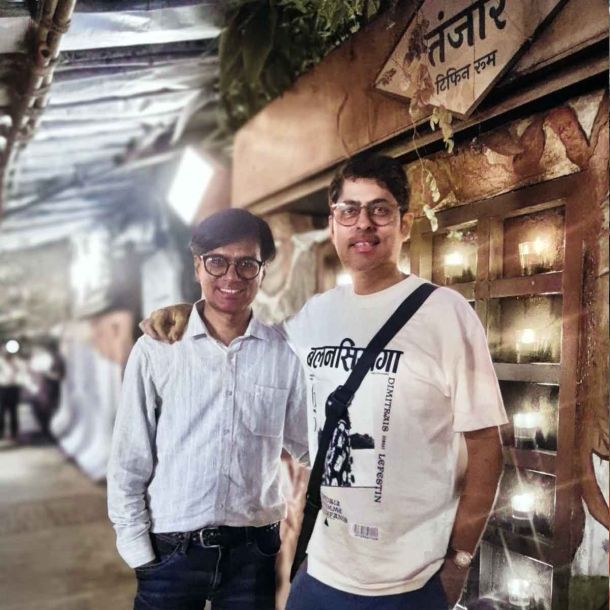More Coverage
Twitter Coverage
Satyaagrah
Written on
Satyaagrah
Written on
Satyaagrah
Written on
Satyaagrah
Written on
Satyaagrah
Written on
JOIN SATYAAGRAH SOCIAL MEDIA
"Structure was a 700-year-old Machindranath temple": Thane's Haji Malang Dargah sees Maharashtra CM Eknath Shinde reassert a historic pledge for its liberation, amid long-standing disputes dating back to the 18th century regarding its Brahmin management

In a recent gathering in Thane, Maharashtra Chief Minister Eknath Shinde reignited discussions surrounding the Haji Malang Dargah, also known as Malanggad, a significant religious site in the Kalyan area. Addressing a religious event on Wednesday, 3rd January, Shinde brought up this enduring issue that holds considerable emotional and cultural importance in the region.
|
Eknath Shinde recalled the Shiv Sena’s longstanding commitment to this cause. He evoked the memory of Anand Dighe, a key figure in Shiv Sena's history, who played a pivotal role in initiating the movement aimed at liberating Malanggad. This movement had given rise to the powerful chant “Jai Malang Shri Malang”, which echoes the sentiments and aspirations of many followers.
In his address, Shinde acknowledged the deep emotions and beliefs of the people regarding the liberation of Malanggad. He stated, “Your sentiments towards Malanggad are well known to me. It was Anand Dighe who initiated the liberation movement of Malanggad, leading us to chant ‘Jay Malang Shri Malang’. However, I must tell you that there are certain matters that aren’t meant for public discussion. I’m aware of the deep-rooted beliefs you hold about Malanggad’s liberation. Let me say this that Eknath Shinde will not stay quiet till he fulfills your wishes.”
|
The Haji Malang Dargah, an important religious site for many, is situated 3000 feet above sea level in the Matheran hill ranges, south of Kalyan. This location, steeped in history and spirituality, draws a significant number of devotees each year. On the 20th of February, followers gather to commemorate the death anniversary of Haji Abd-ul-Rahman, a figure revered as a Sufi saint from the 12th century. His legacy continues to be a source of inspiration and devotion for many.
The history of the dargah took a significant turn in the 1980s due to the involvement of a prominent Shiv Sena leader, Anand Dighe. Dighe, who also served as the political mentor to Eknath Shinde, led a notable movement asserting that the dargah site was originally a Hindu shrine associated with the Nath Panth, a Hindu monastic tradition.
Dighe's agitation was rooted in the belief that the shrine was originally a 700-year-old temple dedicated to Machindranath, a revered figure in the Nath tradition. This claim sparked a movement among followers of the Shiv Sena. In 1996, Dighe escalated his efforts by leading a group of 20,000 Shiv Sainiks to the shrine with the intention of performing pooja (a Hindu ritual), marking a bold assertion of the site's Hindu origins and significance.
Since these developments in the 1990s, the site has been commonly referred to as Shri Malanggad.
The Historical Conflict and Trust Formation at Haji Malang Dargah
The Haji Malang Dargah, a site of historical and religious significance, has experienced its share of conflicts over the centuries. One notable episode began in the 18th century when local Muslims raised objections to the management of the structure by a Brahmin, a member of a Hindu priestly caste. This disagreement highlighted the complex interplay of religious and community dynamics that have historically characterized the region.
The dispute eventually required intervention from a local administrator. In 1817, a unique method was employed to resolve the issue: the decision was made to determine the will of the saint (to whom the dargah is dedicated) by “casting lots.” This practice, though unorthodox, was seen as a way to reach an impartial decision guided by a higher power or fate.
The Gazette records this event with particular detail. It states, “Lots were cast and three times the lot fell on the representative of Kashinath Pant, who was proclaimed the guardian.” This outcome was significant as it led to the Brahmin family of Kashinath Pant being officially recognized as the guardians of the dargah.
Since that decisive event, the Ketkar family, descendants of Kashinath Pant, have served as the trustees of the Haji Malang Dargah Trust. This arrangement has continued for over two centuries, marking a unique instance of religious and administrative crossover.
Presently, the dargah is maintained by a three-member trust. Interestingly, this trust reportedly includes a member from the Hindu Brahmin family, reflecting the site's intricate and layered history of religious coexistence and management.
Chandrahas Ketkar, a descendant of the family that has managed the Haji Malang Dargah for 14 generations, offers a unique perspective on the ongoing debate surrounding the religious site. Addressing claims that the dargah might originally have been a temple, Ketkar suggests that such assertions are motivated by political interests rather than historical facts. He stated, “Anyone claiming that the dargah is a temple is doing it for political mileage,” indicating his belief that the historical identity of the dargah is being used as a tool for political gain rather than being a matter of genuine historical dispute.
Ketkar further refers to a Supreme Court case from 1954, which dealt with an internal dispute within the Ketkar family regarding the control of the dargah. The Supreme Court's observation in this case is significant. It noted that the dargah was a composite structure and thus did not fall strictly under Hindu or Muslim law. Instead, it was to be governed by its own unique customs or the general law of trusts. This ruling highlights the dargah's unique status as a place of worship that transcends conventional religious categorizations, reflecting its composite cultural and religious heritage.
Ketkar also believes that the controversy surrounding the dargah's religious identity is being stirred up for political reasons, particularly to attract a specific vote bank. This viewpoint underscores the complex interplay between religion, history, and politics in India, where religious sites often become focal points of political narratives and agendas.
Adding to the historical context, the Gazetteers of Bombay Presidency, published in 1882, provides an account of the dargah's origins. It mentions that the shrine was built to honor an Arab missionary, Haji Abd-ul-Rahman. According to historical records, he arrived with followers from Yemen and settled on the lower plateau of the hill where the dargah now stands. This account lends support to the view that the dargah has its roots in the Islamic tradition, having been established in recognition of a Muslim missionary's influence in the region.
The history of the Haji Malang Dargah is intertwined with local legends and traditions that have been passed down through generations. One such legend involves Nal Raja, a local king who was in power at the time of Haji Malang. The legend states that Nal Raja's daughter was married to Haji Malang, further cementing the saint's significance in the local culture. This marriage, as per local lore, symbolizes the integration of different cultures and communities. Within the premises of the dargah, the graves of Haji Malang and “Maa Fatima” are located, signifying their eternal union.
These structures and graves have reportedly been in existence since the 12th century. Over the centuries, they have come to be regarded as holy sites, attracting devotees who seek spiritual solace and blessings. The reverence for these graves underscores the deep-rooted spiritual significance that the dargah holds for many.
Abhijit Ketkar, another member of the Ketkar family that manages the trust, highlights the dargah's importance as a pilgrimage site. He notes that thousands of devotees visit the shrine annually to fulfill their “mannat” (vows or wishes). This tradition of visiting the dargah to seek blessings for wishes is a testament to its enduring spiritual influence.
The historical significance of the dargah is further emphasized in The Gazetteers of Bombay Presidency. According to this historical document, in the 18th century, the Maratha Confederacy acknowledged the spiritual power of the saint associated with the dargah. They attributed the departure of the British from certain regions to the saint's divine influence. In recognition of this, offerings were sent to the shrine under the charge of Kashinath Pant Khetkar, a Brahmin from Kalyan.
Pant's involvement went beyond just delivering offerings. He is said to have played a key role in funding repairs and taking over the management of the structure.
The Haji Malang Dargah, with its rich history and cultural significance, represents a unique example of syncretism in India. Rama Shyam, a researcher who has written a thesis on the dargah, provides insightful commentary on its stewardship and the nature of the shrine. According to Shyam, “The stewardship of the dargah rests with a local Brahmin family. It is a syncretic shrine and historically people who are distressed and marginalised irrespective of their faiths visit the shrine.” This statement highlights the inclusive nature of the dargah, emphasizing that it has been a place of solace for people from diverse religious backgrounds, especially those facing hardship or marginalization. The fact that a Brahmin family has been the custodian of this Muslim shrine for generations underlines the dargah's role as a symbol of religious harmony and cultural integration.
In a recent development that underscores the ongoing significance of the dargah in contemporary politics and religion, Maharashtra Chief Minister Eknath Shinde visited the site in February 2023. During his visit, Shinde performed aarti, a Hindu ritual, at the dargah and offered a saffron covering inside the shrine. This act of offering a saffron covering is symbolic in Hindu religious practices and indicates a gesture of respect and devotion.
Shinde’s actions at the dargah are not just religious gestures but also carry political undertones, especially given the historical context of the site and its significance in the local and wider political landscape. By performing aarti and offering a saffron covering, Shinde is seen as bridging religious practices, reflecting the syncretic nature of the shrine.
The fact that CM Eknath Shinde has raised the issue of the dargah once again brings it back into the spotlight, suggesting that it remains a relevant and potentially contentious topic in the region's socio-political discourse.
 |
 Support Us
Support Us
Satyagraha was born from the heart of our land, with an undying aim to unveil the true essence of Bharat. It seeks to illuminate the hidden tales of our valiant freedom fighters and the rich chronicles that haven't yet sung their complete melody in the mainstream.
While platforms like NDTV and 'The Wire' effortlessly garner funds under the banner of safeguarding democracy, we at Satyagraha walk a different path. Our strength and resonance come from you. In this journey to weave a stronger Bharat, every little contribution amplifies our voice. Let's come together, contribute as you can, and champion the true spirit of our nation.
 |  |  |
| ICICI Bank of Satyaagrah | Razorpay Bank of Satyaagrah | PayPal Bank of Satyaagrah - For International Payments |
If all above doesn't work, then try the LINK below:
Please share the article on other platforms
DISCLAIMER: The author is solely responsible for the views expressed in this article. The author carries the responsibility for citing and/or licensing of images utilized within the text. The website also frequently uses non-commercial images for representational purposes only in line with the article. We are not responsible for the authenticity of such images. If some images have a copyright issue, we request the person/entity to contact us at This email address is being protected from spambots. You need JavaScript enabled to view it. and we will take the necessary actions to resolve the issue.
Related Articles
- 'There is a lot more seen inside than imagined, it is beyond the imagination of not only me but all', says Gyanvapi petitioner after coming out of the survey at the disputed structure
- In a significant discovery Hindu temple structure with ornate columns found inside a mosque in Mangaluru, locals suspect the presence of a temple in the past: VHP leaders asked to stop work till documents verified
- Plea rejected by Allahabad High Court to open 22 'closed rooms' of Taj Mahal to research the real history, says "matter should be left to historians. Please don't take us to the historical facts which you believe"
- Hours after Shivling discovered inside disputed Gyanvapi, AIMIM chief Asaduddin Owaisi provokes Muslims against court-ordered proceedings amidst chants of ‘Naara-e-Takbeer’ and ‘Allahu Akbar
- In a major development, Mathura court allowed a plea to remove the disputed structure of the Shahi Idgah Mosque near Krishna Janmabhoomi for hearing: suit filed in the name of "Bhagwan Sri Krishna Virajman"
- Politician Maulana Taukeer Raza Khan claims Temples were not razed, just converted into mosques when people adopted Islam: Issues threat, ‘the day my youths become angry, and take law in their hands, you will have no place to hide’
- Madhya Pradesh HC accepted petition for stay on Muslims performing Namaz in the compound of Bhojshala monument: Read how an educational centre and a historic temple of Goddess Saraswati became Kamal Maulana mosque
- 'Found stone carvings of Hindu Gods-Goddesses, lotus, Seshnaag, Shrigar Gauri shrine distinctly visible, absolute remnants of ancient Hindu temple': Survey commissioner Ajay Mishra reports, Muslim side continuously uncooperative
- 1200 years old rarest idol of Lord Narasimha and devotee Prahlada identified in Qutub Minar complex by renowned archaeologist Dharamveer Sharma: special attraction for religious and researching community
- "Shut down encroached illegal Bhagya Lakshmi temple if Govt don't allow Namaz in Charminar mosque", says Congress leader Rashed Khan: Began a signature campaign at the Mecca Masjid near Charminar
- Muslims pretended to offer Friday Namaz, gathered mob at Gyanvapi Mosque in Varanasi and raised religious slogans as the survey and videography of disputed structure started
- Hundred reasons why the Story of the Taj Mahal that most of us have known about may not be the real truth: It's is not an Islamic mausoleum but an ancient Shiva Temple known as Tejo Mahalaya
- Jamia Masjid in Srirangapatna is actually an ancient Anjaneya Hanuman temple that was captured and converted into Masjid by Tipu Sultan: Claims activists and seek permission to worship inside the mosque
- Rajasthan: Oldest mosque of Ajmer ‘Adhai Din Ka Jhonpra’ stands over ruins of a magnificent Sanskrit pathshala 'Saraswati Kanthabharan Mahavidyalay': Hindu and Jain temple features found, structure still used by Muslims for Namaz
- "मज़ार का ज़िद्दी जुनून": An unauthorized mazar by Pune Airport forced a wall change, raising security fears—a complaint to Muralidhar Mohol flags traffic woes and a trend of illegal builds near vital spots like Mumbai and Navi Mumbai airports




























